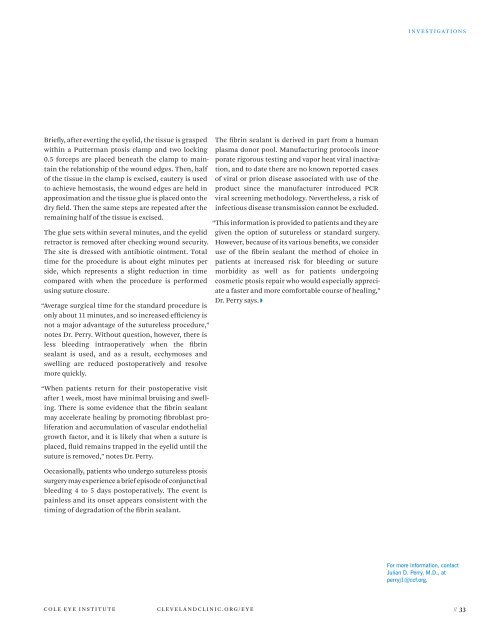Ophthalmology Update - Cleveland Clinic
Ophthalmology Update - Cleveland Clinic
Ophthalmology Update - Cleveland Clinic
Create successful ePaper yourself
Turn your PDF publications into a flip-book with our unique Google optimized e-Paper software.
Briefly, after everting the eyelid, the tissue is grasped<br />
within a putterman ptosis clamp and two locking<br />
0.5 forceps are placed beneath the clamp to maintain<br />
the relationship of the wound edges. then, half<br />
of the tissue in the clamp is excised, cautery is used<br />
to achieve hemostasis, the wound edges are held in<br />
approximation and the tissue glue is placed onto the<br />
dry field. then the same steps are repeated after the<br />
remaining half of the tissue is excised.<br />
the glue sets within several minutes, and the eyelid<br />
retractor is removed after checking wound security.<br />
the site is dressed with antibiotic ointment. total<br />
time for the procedure is about eight minutes per<br />
side, which represents a slight reduction in time<br />
compared with when the procedure is performed<br />
using suture closure.<br />
“average surgical time for the standard procedure is<br />
only about 11 minutes, and so increased efficiency is<br />
not a major advantage of the sutureless procedure,”<br />
notes dr. perry. Without question, however, there is<br />
less bleeding intraoperatively when the fibrin<br />
sealant is used, and as a result, ecchymoses and<br />
swelling are reduced postoperatively and resolve<br />
more quickly.<br />
“When patients return for their postoperative visit<br />
after 1 week, most have minimal bruising and swelling.<br />
there is some evidence that the fibrin sealant<br />
may accelerate healing by promoting fibroblast proliferation<br />
and accumulation of vascular endothelial<br />
growth factor, and it is likely that when a suture is<br />
placed, fluid remains trapped in the eyelid until the<br />
suture is removed,” notes dr. perry.<br />
Occasionally, patients who undergo sutureless ptosis<br />
surgery may experience a brief episode of conjunctival<br />
bleeding 4 to 5 days postoperatively. the event is<br />
painless and its onset appears consistent with the<br />
timing of degradation of the fibrin sealant.<br />
the fibrin sealant is derived in part from a human<br />
plasma donor pool. manufacturing protocols incorporate<br />
rigorous testing and vapor heat viral inactivation,<br />
and to date there are no known reported cases<br />
of viral or prion disease associated with use of the<br />
product since the manufacturer introduced pcr<br />
viral screening methodology. nevertheless, a risk of<br />
infectious disease transmission cannot be excluded.<br />
“this information is provided to patients and they are<br />
given the option of sutureless or standard surgery.<br />
however, because of its various benefits, we consider<br />
use of the fibrin sealant the method of choice in<br />
patients at increased risk for bleeding or suture<br />
morbidity as well as for patients undergoing<br />
cosmetic ptosis repair who would especially appreciate<br />
a faster and more comfortable course of healing,”<br />
dr. perry says.<br />
i n v e s t i g a t i O n s<br />
For more information, contact<br />
Julian D. Perry, M.D., at<br />
perryj1@ccf.org.<br />
c O l e e y e i n s t i t U t e c l e v e l a n d c l i n i c . O r g / e y e //
















